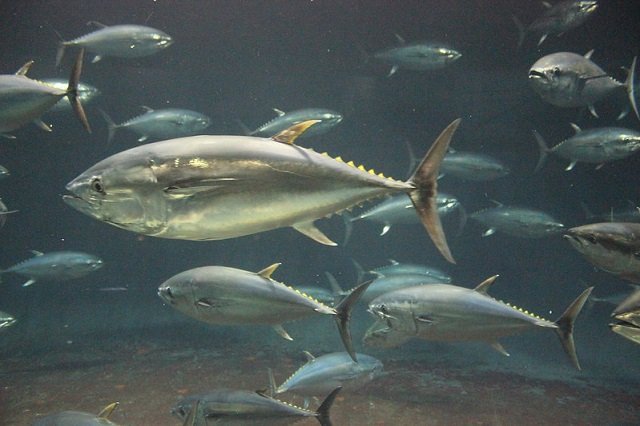By Amod Ashok Salgaonkar
The mangrove red snapper Lutjanus argentimaculatus (Forsskål 1775) is a euryhaline species occurring in Indian ocean, Indo & West Pacific Ocean and eastern Mediterranean Sea. It is the most important species of the family Lutjanidae composed of 17 genera and 103 species of mostly reef associated marine fishes.
Among all the snapper species, the mangrove red snapper is considered as the fast growing species and can attain a body weight of 1.0 kg in a culture period of 6-8 months. In the nature, juveniles and young adults occur in mangrove estuaries, the lower reaches of freshwater streams and tidal creeks. Adults are often found in groups around coral reefs. Red snapper is carnivorous and predates on fish, crustaceans and molluscs. Red snappers are excellent brackishwater candidate species due to its euryhaline nature and it can be farmed both in the ponds and in cages. Mangrove red snapper is one of the most preferred food fishes globally due to its white tender meat.
In India, attempts to develop techniques for captive reproduction of red snapper was initiated during 2016. Development of aquaculture of red snapper in India is limited by the consistent availability quality seed for stocking in nursery and grow-out systems. Therefore, ICAR-CIBA has given a high impetus to develop a complete hatchery technology of red snapper including broodstock development, captive maturation, induced breeding and larval. In a major boost to diversification of brackishwater aquaculture in the country, the ICAR-Central Institute of brackishwater Aquaculture (CIBA) has announced today a successful breakthrough of seed production technology of Mangrove Red Snapper, a high value fish, for the first time in India
This is expected to open up enormous scope for the country’s brackishwater aquaculture ventures in near future, considering the delicacy and handsome price red snapper fetches in the market. Due to the texture, taste and limited spines of this species, the consumer preference is high, and consistent demand from the consumers provide stable market price in the range of Rs.400 to Rs.600/kg. Locally known as Seppili (in Tamil), ‘Chempally’ in Malayalam or ‘Tam’ in Marathi, the fish has immense potential for brackishwater aquaculture owing to its fast growth rate, easy adaptability to culture conditions, quick acceptance of artificial feed, pleasant appearance and good meat quality. It is an ideal candidate species suitable for different rearing systems such as pond, pens and cages. This species which readily accept formulated feed can grow to marketable size of 300-500 gm in less than six months, making this fish a farmer’s choice.
Earlier the CIBA had developed the hatchery technology of sea bass, milkfish and grey mullet. “With this achievement, the CIBA has introduced one more candidate species for brackishwater aquaculture diversification and sustainability”, said Dr K K Vijayan, Director of CIBA. “Now, the fish farmers have diversified options to choose their candidate species for aquaculture. The feat will help increase the domestic production through brackishwater aquaculture in the country”, he added.
Dedicating the technology to the nation, Dr J K Jena, Deputy Director General of Indian Council of Agricultural Research (ICAR) described the development a milestone in Indian brackishwater aquaculture sector.
The first batch of fingerlings bred by CIBA was distributed to selected fish farmers from Tamil Nadu and Kerala. “The farmers will grow the fingerlings at their respective farms and will return the selected broodstock to the CIBA on a buy-back mode for further breeding in the hatchery”, said Dr. Kailsam, who led the team of researchers to develop the technology. He hoped that private players would come forward to adopt this hatchery technology so that seed production could be scaled up.
Stay Always Informed
Join our communities to instantly receive the most important news, reports, and analysis from the aquaculture industry.
Source: The Director, CIBA
Editor at the digital magazine AquaHoy. He holds a degree in Aquaculture Biology from the National University of Santa (UNS) and a Master’s degree in Science and Innovation Management from the Polytechnic University of Valencia, with postgraduate diplomas in Business Innovation and Innovation Management. He possesses extensive experience in the aquaculture and fisheries sector, having led the Fisheries Innovation Unit of the National Program for Innovation in Fisheries and Aquaculture (PNIPA). He has served as a senior consultant in technology watch, an innovation project formulator and advisor, and a lecturer at UNS. He is a member of the Peruvian College of Biologists and was recognized by the World Aquaculture Society (WAS) in 2016 for his contribution to aquaculture.




